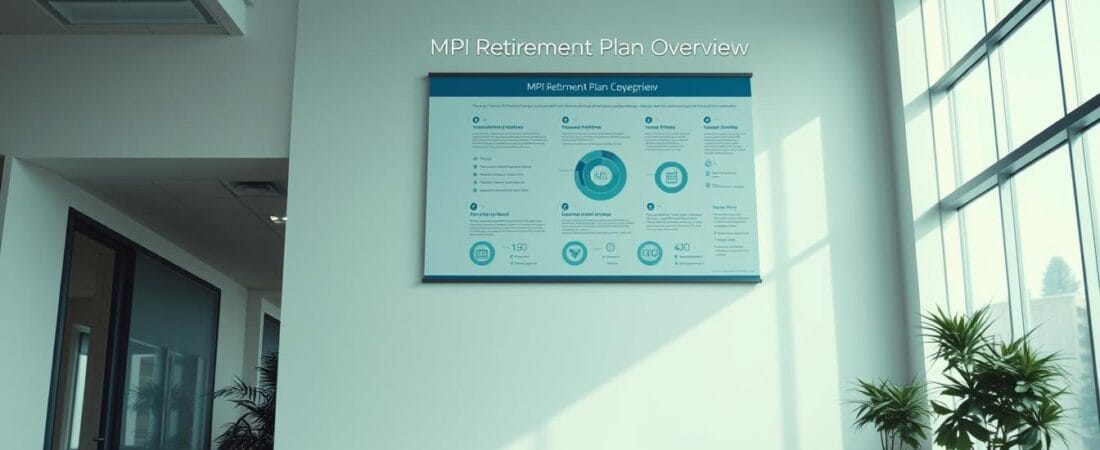Surprising fact: more than half a million Americans hold indexed life policies that use floors and index credits to protect growth.
An MPI® retirement plan overview frames a trademarked approach that uses an indexed universal life insurance chassis to blend security, growth, and leverage. It aims to give households downside protection across shifting market conditions while offering tax-advantaged access through policy loans.
The core idea pairs an insurance-backed 0% floor with index-linked credits. That mix seeks to reduce sequence-of-returns risk compared with some traditional retirement choices.
Advisors who follow Suncor Financial and Curtis Ray stress disciplined contributions, compounding, and careful policy design. When structured properly, cash value growth and loans can create potential income streams without mandatory age penalties.
Note: advocates promote “secure leverage” and tax-free legacy benefits via a death benefit, but outcomes depend on funding discipline, policy costs, and strict adherence to terms.
Key Takeaways
- Uses a life insurance chassis to combine downside protection and growth.
- Pairs a 0% floor with index credits to limit sequence risk.
- Depends heavily on disciplined contributions and policy design.
- Offers tax-advantaged access through policy loans and a death benefit.
- Compare it to traditional retirement choices to see where it fits your goals.
Defining MPI in Plain English

Think of MPI as a guarded growth method that uses an indexed universal life product to earn credits tied to market indexes while blocking losses in down years.
In plain terms: it is an indexed universal life insurance policy offered through a branded approach. You pay premiums and the policy builds a cash value that receives index-linked credits (for example, tied to the S&P 500). Those credits follow a formula with a cap and participation rate. A 0% floor often prevents negative years from reducing credited growth.
The contract has clear terms: premiums, policy charges, and credit rules. The account value shows what gets credited and used to pay costs. The cash value is the portion you can access by surrender or borrowing.
“This design centralizes the crediting process with the insurer rather than placing your money directly into the stock market.”
Contributions must be steady to keep the policy healthy. Access to income usually happens via policy loans or withdrawals. If the policy stays in force and is well-funded, loans can provide tax-advantaged income streams.
- Caps, participation, and the floor shape growth expectations.
- It includes life coverage, so a death benefit sits alongside cash value accumulation.
- Compared to a Roth IRA, this model trades direct market control for an insurer-driven crediting formula and an explicit loss floor.
| Feature | What it means | Why it matters |
|---|---|---|
| Indexed crediting | Returns linked to an index formula | Offers upside without direct market ownership |
| 0% floor | No negative credited returns in down years | Reduces sequence-of-returns risk |
| Account vs Cash Value | Account covers charges; cash value is accessible | Helps plan funding and withdrawal strategy |
For a broader view of providers and life insurance options, see this top life insurance companies guide to compare carrier strength and product design.
How an MPI Plan Works Under the Hood

Quick view: an indexed universal life contract turns regular contributions into life coverage plus an insurer‑credited cash reserve. That reserve grows by credits set with caps and participation, not by direct stock market ownership.
Indexed universal life basics
The life insurance policy portion covers beneficiaries while the account portion builds cash value. Premiums pay both costs and accumulation. Early funding matters because policy charges rise with age and can offset credits.
Account credits, caps, and the 0% floor
The account value receives annual dividend credits tied to an index formula. A cap and participation rate limit upside. A 0% floor prevents negative credited years, but the policy still incurs charges.
Surrender charges and early years
Surrender charge schedules often taper each year and may extend to the 14th year. Exiting in the early period can leave you with reduced cash value and higher costs.
Access mechanics: loans and RELOC
Loans provide liquidity without immediate tax when the policy stays in force, yet loan interest accrues and must be managed. Some advisors call this a retirement equity line of credit; it works only if loan‑to‑value stays acceptable and the policy is funded.
- Design matters: contributions, caps, the floor, and loan management together shape long‑term outcomes.
- Consult a qualified advisor (for example, Curtis Ray advocates disciplined funding) and compare options like a top Roth IRA providers.
| Mechanic | Why it matters | Typical effect |
|---|---|---|
| Crediting formula | Sets growth potential | Upside limited by caps |
| Surrender period | Protects insurer, limits early exits | Charges decline over years |
| Policy loans | Provide tax‑favored access | Loan interest reduces cash value |
mpi retirement plan overview: Benefits, Features, and Limitations

This approach blends downside protection with limited upside to create a steadier accumulation path.
Security and growth potential: a 0% floor helps shield credited value in down years while index‑linked credits offer upside subject to caps. That mix can support steady compounding and offer a predictable base for later distributions.
Tax treatment and access
After‑tax contributions grow inside the contract. Policy loans may offer tax‑advantaged income if the contract stays in force, and the death benefit can pass to heirs income‑tax‑free. Use conservative assumptions when comparing to a 401(k) alternative or a roth ira.
Costs, risks, and practical limits
- Costs: insurance charges rise with age and fees persist in low-credit years.
- Lapse risk: inadequate funding or heavy borrowing can drain cash value and risk policy lapse.
- Surrender charges: early exit costs can extend through the 14th year of the period.
- Health: underwriting and changing insurability affect pricing and available features.
| Feature | Why it matters | Typical effect |
|---|---|---|
| 0% floor | Limits downside | Reduces sequence risk |
| Loans | Access income | Interest accrues |
| Surrender schedule | Exit cost control | Higher early fees |
MPI vs. Roth IRA: Which Retirement Path Fits Your Situation?

Choosing the right vehicle begins with clarity about funding, access, and control.
Contribution rules and flexibility: A Roth IRA uses after-tax contributions and has statutory limits (2024: $7,000 under 50; $8,000 50+). Income caps can restrict high earners. By contrast, an insurer-backed contract does not face annual contribution caps, giving higher earners room to add funds as their circumstances change.
Access and early withdrawal differences
Roth IRA qualified withdrawals are tax-free after age 59½ and a five-year holding period. Early earnings withdrawals often incur a 10% penalty plus taxes.
With an insurer policy, owners can use policy loans for retirement income without immediate IRS early withdrawal penalties, provided the policy stays in force.
Investment control and market exposure
Roth IRAs offer broad stock market choices and self-directed control or advisor management.
Insurer crediting formulas cap upside and add a 0% floor, trading direct control for downside protection in varying market conditions.
Which to choose?
- Pick a Roth IRA if you value broad investment menus, simple tax rules, and no RMDs.
- Consider the insurer option if you need higher contribution capacity and potential early access to income via loans.
- Many people split contributions made between vehicles to balance tax treatment and access.
| Feature | Roth IRA | Insurer-backed policy |
|---|---|---|
| Contribution limits | Statutory caps ($7k/$8k in 2024) | No IRS annual caps; subject to underwriting |
| Early access | Earnings taxed + 10% penalty before rules met | Policy loans allow access without IRS early withdrawal penalty if managed |
| Investment control | Direct stock market selection | Carrier-managed credits with caps and a 0% floor |
| Required minimum distributions | No RMDs | Access depends on loans, charges, and policy design |
Frequently asked questions often focus on tax rules, contributions, and what fits specific life circumstances. Run scenarios for age, income, and planned income streams to decide whether a Roth IRA, an insurer contract, or both best match your goals.
Who Might Consider MPI? Matching the Plan to Life Circumstances

This approach often suits people who can commit steady funding over many years and tolerate early policy costs.
Time horizon and contributions made: The structure rewards a long runway. Consistent contributions made during the early years help absorb front-loaded charges and let cash value grow over time. If you expect to stay disciplined for several years, the odds of keeping the contract in force improve.
Likely candidates: High earners and HENRYs who need ways to save beyond Roth IRA caps often fit these circumstances. These households may value tax-efficient access to income and the ability to fund larger sums than statutory retirement accounts allow.
Steady funding and active management matter. Charges, loan interest, and policy mechanics require attention across market cycles. Owners must monitor loan levels and premium pacing to avoid lapses.
Other circumstances to weigh
- Those who prioritize downside protection, legacy (life insurance) benefits, and flexible access to distributions may find alignment here.
- If you prefer direct market control or have limited contribution capacity, a roth ira comparison remains attractive for many savers.
- Underwriting and health affect feasibility—acceptance and pricing influence long‑term suitability.
In short, evaluate income stability, savings rate, and tolerance for an insurance-based structure before deciding. Time and patience improve outcomes: the more years you can contribute steadily, the better the chance of offsetting costs and preserving your financial future.
Key Mechanics to Understand Before You Start

Before you buy, understand how premium sizing and face amount choices shape long-term outcomes.
Policy design choices: premiums, face amount, and universal life terms
Size premiums so charges and realistic credits leave positive cash value each year. Set a face amount that covers your goals but does not overburden early costs.
Watch surrender schedules: some grow lighter after a 14-year period. Verify illustration assumptions and how changes affect long-run results.
The role of the company and advisor: Suncor Financial and Curtis Ray context
Work with a reputable company and a knowledgeable advisor. Suncor Financial and Curtis Ray provide designs and education that help owners match funding to objectives.
Ask for clear terms and an in-force ledger. Review projected credits, charges, and how contributions will be applied each year.
Loans, loan interest, and keeping the policy in force through market cycles
Use conservative loan limits and track loan interest annually. High borrowing can erode cash value and raise lapse risk during low-credit years.
Stress-test scenarios for high and low credit periods. Revisit funding if projections drift. Documentation and regular reviews with your company advisor preserve flexibility.
| Mechanic | Action | Why it matters |
|---|---|---|
| Premium & face amount | Model realistic funding | Keeps cash value positive over time |
| Advisor & company | Request illustrations, in-force ledgers | Ensures transparency and ongoing support |
| Loans & loan interest | Limit borrowing; review annually | Protects against lapse and reduces risk |
| Stress testing | Simulate varied credit years | Reveals funding gaps before they occur |
For guidance on income distribution strategies and comparing options, see these retirement income strategies.
Important Clarification: MPI vs. Motion Picture Industry Pension & Health Plan
Don’t confuse an insurer-backed indexed life strategy with the union health and pension trust used by film crews.
Quick distinction: this guide’s MPI refers to a life insurance product approach. The Motion Picture Industry Pension & Health Plan (MPIPHP) is a separate benefits trust for qualified production professionals.
Picture industry pension health coverage and eligibility requirements
The MPIPHP is funded mainly by employer contributions when producers work on eligible productions under the Non‑Affiliate Agreement.
To qualify for initial health coverage you typically must hit 600 hours in a six‑month period. Continuing coverage commonly needs 400 hours per subsequent six‑month period. Some hours may be banked under specific rules.
How the Motion Picture plan differs from an MPI life insurance product
Contributions to the MPIPHP are not automatic for non‑affiliate hires; you must file a participation form within 60 days of starting eligible employment or you may subject yourself to loss of coverage for that production.
Credited hours count toward pension credit. After 400 credited hours in a year you earn a qualified year; vesting usually occurs after five qualified years.
- Important: an insurer-backed indexed policy does not grant union health eligibility or picture industry pension benefits.
- Plan websites publish a privacy policy, cookie notices, and frequently asked questions—review them for details.
| Feature | MPIPHP | Insurer-indexed product |
|---|---|---|
| Primary purpose | Health & pension for production workers | Cash accumulation + life coverage |
| Eligibility | AMPTP or IA signatory employment, hours thresholds | Underwriting and premium funding |
| Enrollment | Non-affiliate form within 60 days | Purchase and contract terms with insurer |
For related provider comparisons, see this guide on disability insurance providers.
Getting Started and Staying Compliant
Start by defining measurable goals and a funding rhythm that fits your monthly budget and long-term time frame. Decide what you need for income, legacy, and access, then compare that to traditional accounts and insurer-backed alternatives.
Set targets, then translate them into realistic contributions and a time horizon you can sustain. Review illustrations and verify charges, caps, floors, and surrender schedules by year and period before you sign any terms.
Setting goals, comparing options, and reviewing terms
Document your assumptions and model several scenarios. Track contributions, loan conditions, and how fees affect cash value over time.
Keep an annual checklist to confirm policy health, beneficiary designations, and in‑force illustrations. Schedule a yearly review with your company or advisor.
Privacy policy, cookies, and protecting your financial data
Read the provider’s privacy policy and cookie notices. Confirm encryption, multi‑factor authentication, and account access controls before sharing sensitive documents.
- Missing administrative deadlines may subject you to loss of coverage; the motion picture industry and picture industry pension examples show how strict timelines can be.
- Keep secure records of all contributions and confirmations by time and year.
- Consult licensed professionals to align the approach with other accounts and to validate loan or withdrawal assumptions.
“Treat documentation and annual reviews as part of your contribution discipline; they reduce surprise costs and protect long-term outcomes.”
| Action | Why it matters | Timing |
|---|---|---|
| Review privacy policy | Protects personal and financial data | At signup and annually |
| Document contributions | Evidence for performance & tax records | Each contribution |
| Annual policy check | Detects changes in terms or lapse risk | Once per year |
Conclusion
When funded over time and managed closely, an indexed life product can offer downside protection and structured access to income through policy loans.
By contrast, a Roth IRA gives direct market control and simple, tax‑free qualified withdrawals.
Many households combine both to diversify tax treatment and access rules. Match choices to your savings capacity and time horizon. High earners with steady contributions may favor an insurer option; those seeking simplicity often choose a Roth IRA.
Before you act, review illustrations, fee schedules, surrender timelines, and projected income scenarios. Stress‑test assumptions and map timelines that protect your financial future.
Start by comparing projections and then consult a licensed advisor. For planning tools and practical next steps, see this guide to plan your retirement with AI-powered tools.

